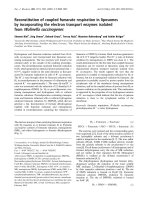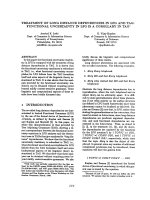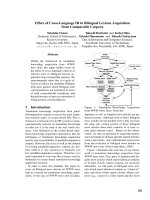Báo cáo khoa hoc:" Exclusion of PINK1 as candidate gene for the late-onset form of Parkinson''''s disease in two European populations" pps
Bạn đang xem bản rút gọn của tài liệu. Xem và tải ngay bản đầy đủ của tài liệu tại đây (227.11 KB, 4 trang )
BioMed Central
Page 1 of 4
(page number not for citation purposes)
Journal of Negative Results in
BioMedicine
Open Access
Research
Exclusion of PINK1 as candidate gene for the late-onset form of
Parkinson's disease in two European populations
Anna Melissa Schlitter*
1
, Martin Kurz
2,3
, Jan P Larsen
3
, Dirk Woitalla
4
,
Thomas Mueller
4
, Joerg T Epplen
1
and Gabriele Dekomien
1
Address:
1
Department of Human Genetics, Ruhr-University Bochum, Germany,
2
Department of Neurology, Heinrich-Heine-University
Düsseldorf, Germany,
3
Department of Neurology, Stavanger University Hospital, Norway and
4
Department of Neurology, St. Josef-Hospital, Ruhr-
University Bochum, Germany
Email: Anna Melissa Schlitter* - ; Martin Kurz - ; Jan P Larsen - ;
Dirk Woitalla - ; Thomas Mueller - ; Joerg T Epplen - ;
Gabriele Dekomien -
* Corresponding author
Abstract
Background: Parkinson's disease (PD) is the second most common neurodegenerative disorder.
Recently, mutations in the PINK1 (PARK6) gene were shown to rarely cause autosomal-recessively
transmitted, early-onset parkinsonism. In order to evaluate whether PINK1 contributes to the risk
of common late-onset PD we analysed PINK1 sequence variations. A German (85 patients) and a
Norwegian cohort (90 patients) suffering from late-onset PD were screened for mutations and
single nucleotide polymorphisms (SNPs) in the PINK1 gene. Both cohorts consist of well-
characterized patients presenting a positive family history of PD in ~17%. Investigations were
performed by single strand conformation polymorphism (SSCP), denaturating high performance
liquid chromatography (DHPLC) and sequencing analyses. SNP frequencies were compared by the
χ
2
test
Results: Several common SNPs were identified in our cohorts, including a recently identified
coding variant (Q115L) in exon 1. Genotyping of the Q115L variation did not reveal significant
frequency differences between patients and controls. Pathogenic mutations in the PINK1 gene were
not identified, neither in the German nor in the Norwegian cohort.
Conclusion: Sequence variation in the PINK1 gene appears to play a marginal quantitative role in
the pathogenesis of the late-onset form of PD, in German and Norwegian cohorts, if at all.
Background
PD is the second most common neurodegenerative disor-
der after Alzheimer disease affecting more than 1% of the
population by the age of 65 years. Mutations in the alpha-
synuclein (PARK1), Parkin (PARK2) and DJ-1 (PARK7)
gene cause fairly rare familial forms of PD characterized
by an early age of onset. Mutations in the recently identi-
fied LRRK2 (PARK8) gene, especially the common muta-
tion G2019S, occur more frequently in patients suffering
from early as well as late-onset PD [1,2]. Recently, muta-
tions in the PINK1 (PARK6) gene were shown to cause
autosomal recessively transmitted early-onset parkinson-
ism [3,4]. The PINK1 (PTEN-induced kinase 1) gene
encodes a putative protein kinase. The protein is targeted
Published: 14 December 2005
Journal of Negative Results in BioMedicine 2005, 4:10 doi:10.1186/1477-5751-4-10
Received: 10 July 2005
Accepted: 14 December 2005
This article is available from: />© 2005 Schlitter et al; licensee BioMed Central Ltd.
This is an Open Access article distributed under the terms of the Creative Commons Attribution License ( />),
which permits unrestricted use, distribution, and reproduction in any medium, provided the original work is properly cited.
Journal of Negative Results in BioMedicine 2005, 4:10 />Page 2 of 4
(page number not for citation purposes)
to mitochondria and shows a serine-threonine kinase
domain with homology to kinases of the Ca
2+
/calmodu-
lin family[3]. It appears to exert protective effects against
cellular stress within mitochondria[3]. These findings link
mitochondria directly to the pathogenesis of PD [3,5]. An
additional link between mitochondrial dysfunction and
PD is obvious via the identification of disease causing
mutations in the Omi/HtrA2 gene [6]. The hypothesis of
mitochondrial impairment was further emphasized by
postmortem studies of PD brains [7] and observation of
PD syndromes after intoxication with mitochondrial
complex I inhibitors, such as MPTP (1-methyl-4-phenyl-
1,2,3,6-tetrahydropyridine) and rotenone [8]. Mutations
in the PINK1 gene are the second most common cause of
autosomal-recessively inherited early-onset PD after
mutations in the Parkin gene. On the other hand, strong
evidence was reported for a possible role of Parkin gene
variations in the late-onset form of PD (age of onset >45
years): Parkin mutations appear to contribute to the com-
mon late-onset form and mutations, especially in exon 7
in heterozygous state, may play a role as susceptibility
alleles for sporadic PD[9,10]. The question arises as to
whether the PINK1 gene is also a candidate gene for late-
onset forms of Parkinson's disease, similar to the sug-
gested role of the Parkin gene.
Here we report of a population-based analysis of sequence
variations within the PINK1 gene. The German cohort
includes 85 patients suffering from late-onset form of PD
and represents a modern urban population with a genetic
heterogeneity. In contrast, the Norwegian cohort repre-
sents a more homogeneous population [11] and includes
90 patients suffering from late-onset form of PD.
Results
All 8 coding exons of the PINK1 gene were screened for
sequence variation using SSCP and sequencing analyses.
Several SNPs were identified in our cohorts (L63L, Q115L,
Ivs4-5A>G het, Ivs6+43C>T het, N521T, c.1783A>T).
Allelic frequencies of several SNPs differed significantly
between the two European cohorts confirming homoge-
neity of the Norwegian cohort (Table 1). Patients and con-
trols were genotyped for the recently identified variation
Q115L [12] using DHPLC analysis (Table 2). The
observed frequencies did not differ significantly between
patients and controls, neither in the German (p = 0.27)
nor in the Norwegian cohort (p = 0.8). This screening did
not reveal any disease-relevant mutation in our cohorts.
Discussion
As recently shown, mutations in the PINK1 gene rarely
cause autosomal-recessively transmitted PD [3]. Besides
an early age of onset, the observed clinical symptoms in
PD caused by PINK1 are similar to symptoms in idio-
pathic PD.
In this population-based study, we investigated whether
sequence variations in the PINK1 gene play a role in the
late-onset form of PD. A recently described variation
(Q115L) of the PINK1 gene [12] was identified in the Ger-
man and the Norwegian cohorts. We calculated allele fre-
quencies in cases and controls and show here that the
Q115L variant was not associated with late-onset PD in
our study. These findings correspond to previously pub-
lished data of no leading association of other coding SNPs
within the PINK1 gene and PD [13]. In addition, several
common SNPs were identified. We did not find any path-
Table 1: Allelic frequencies of identified SNPs in Norwegian (NW) and German (G) patient cohorts
Exon Sequence variation Allelic frequencies p-value *distribution is
significant
NW G
1 Q115L 0.072 0.035 0.13
1 L63L 0.083 0.218 0.0004 *
5 Ivs4-5A>G 0.017 0.091 0.002 *
6 Ivs6+43C>T 0.041 0.102 0.029 *
8 N521T 0.128 0.188 0.13
8 c.1783A>T 0.201 0.2 0.98
Table 2: Genotyping of the Q115L variation
Norwegian cohort German cohort
Patients
(n = 90)
Controls
(n = 136)
p Patients
(n = 85)
Controls
(n = 210)
p
Q115 (Wildtype) 80 118 0.8 79 190 0.27
Q115L 7 18 6 16
L115 30 04
Journal of Negative Results in BioMedicine 2005, 4:10 />Page 3 of 4
(page number not for citation purposes)
ogenic mutation of the PINK1 in our cohorts composed of
patients suffering from late-onset form of PD. The risk to
miss potential mutations was minimized by a well estab-
lished and optimized SSCP analyses.
The most likely reason to explain the absence of muta-
tions in our cohorts is the lack of influence of the PINK1
gene in the pathogenesis of late-onset PD. Individual tag-
ging SNPs and tag-defined haplotypes in 500 PD patients
likewise did not reveal associations with PD [14]. Future
investigations should include screening of potential pro-
moter as well as enhancer/silencer regions of the gene to
finally exclude any lack of influence of PINK1 variation on
PD manifestation. Yet, functional investigations of the
PINK1 protein are necessary to identify potential interac-
tion partners as candidates for additional mutation
screening.
Conclusion
Investigations of other genes involved in the mitochon-
drial pathway of the PINK1 gene are necessary to evaluate
the exact role of mitochondrial impairment for common
forms of PD.
Materials and methods
Patients and controls
The Norwegian cohort (n = 90) consists of patients suffer-
ing from late-onset PD (median age of onset 64.4 years,
range from 49 to 78 years, standard deviation 7.9) origi-
nated from the Stavanger area of Western Norway. This
population is known to be genetically quite homogene-
ous [11] and has previously been described in several clin-
ical PD studies [15,16]. 16.7% of the patients presented a
positive family history for PD concerning first degree rela-
tives (siblings or parents). All patients meet the criteria for
PD [15,17] and were thoroughly clinically examined. An
ethnically matched control group of healthy blood
donors was recruited in Bergen, Norway. The German
cohort (n = 85) consists of patients of the Ruhr area suf-
fering from late-onset PD (median age of onset 58.7 years,
range from 45 to 79 years, standard deviation 8.7) diag-
nosed according to the UK Brain Bank criteria [18]. 16.5%
of the patients presented a positive family history for PD
concerning first degree relatives (siblings or parents). Eth-
nically matched control samples from senior healthy
blood donors (median age 57.2 years, range from 42 to 68
years, standard deviation 5.7) were recruited at the neigh-
bouring University Hospital of Essen (Germany). Popula-
tion stratification was excluded for the controls by
multiple microsatellites analyses. After receiving informed
consent from the patients, peripheral blood samples were
taken and genomic DNA was extracted following standard
protocols. German (Bochum and Düsseldorf) and Norwe-
gian (Bergen) ethics committees approved this study.
SSCP, DHPLC, sequencing
The 8 coding exons of the PINK1 gene were amplified by
polymerase chain reaction (PCR) in all patients using
designed primer pairs adapted to the SSCP technique
(Table 3). SSCP analysis according to standard procedure
[19] was used to identify mutations and SNPs. In order to
optimize mutation screening by SSCP analyses, PCR prod-
ucts were digested with different restriction enzymes
depending on the lengths of their fragments [19] and
screened in two different conditions. Selected samples
with band shifts evidenced in SSCP analyses were con-
firmed by direct sequencing. The sequence reactions were
run on an automated DNA sequencer (Applied Biosys-
tems 377 XL, Foster City, USA) and analyzed with the ABI
Prism™ 377 XL collection and convenient sequencing
analysis software. SNP frequencies of the Q115L variation
in patients and controls were determinated by using
DHPLC analyses (WAVE
®
system, Cheshire, UK, using
software Wavemaker 4.1) according to established proce-
dures.
Statistical analyses
SNP frequencies were compared by the χ
2
test. We consid-
ered P-values < 0.05 as significant.
Authors' contributions
AMS carried out the molecular genetic studies, performed
the statistical analysis and drafted the manuscript. MK
participated in devising the study based on thoroughly
clinical analysis of the patients. JPL supervised data collec-
tion and diagnosis of the Norwegian cohort. DW and TM
provided the samples and performed clinical diagnostics
of the German patient group. JTE conceived of the study,
and participated in its design and coordination and
Table 3: Primers for PINK1 gene analysis
Exon Primer sequence Product
size (bp)
Ex 1 F 5'-AAGTTTGTTGTGACCGGCG-3'
R 5'-CTTAGCTCCGTCCTCCGCT-3'
507
Ex 2 F 5'-CCTTCCTAGGCTCCCTGGC-3'
R 5'-AAGATGGGCATTTTGAGAACATCT-3'
387
Ex 3 F 5'-GCTTACAAGGAACTTACCATTCTGC-3'
R 5'-GTGCTGAGGACATAAGTGATGGAT-3'
240
Ex 4 F 5'-GATGTATCAGCTCCAGGCCCT-3'
R 5'-TATTCTTTCCAGGTGTTGTATCTGATG-3'
286
Ex 5 F 5'-AAACGTATTGGGAGTCGTCGA-3'
R 5'-CTCTAGTGCCCCTGGAGAGCT-3'
266
Ex 6 F 5'-CGAGTCTCCTGCATTCAGTGG-3'
R 5'-GACATAGCAGGGCCTCTCAGAG-3'
265
Ex 7 F 5'-TCAGGTGATGTGCAGGACATG-3'
R 5'-CAGAGGTTTCTACCCACACCG-3'
358
Ex 8 F 5'-GGACCAGAGAAGGGAAGACCC-3'
R 5'-TCACGACACAGAGGATGCCA-3'
410
Publish with BioMed Central and every
scientist can read your work free of charge
"BioMed Central will be the most significant development for
disseminating the results of biomedical research in our lifetime."
Sir Paul Nurse, Cancer Research UK
Your research papers will be:
available free of charge to the entire biomedical community
peer reviewed and published immediately upon acceptance
cited in PubMed and archived on PubMed Central
yours — you keep the copyright
Submit your manuscript here:
/>BioMedcentral
Journal of Negative Results in BioMedicine 2005, 4:10 />Page 4 of 4
(page number not for citation purposes)
helped to draft the manuscript. GD supervised AMS, espe-
cially the molecular studies. All authors read and
approved the final manuscript.
Acknowledgements
We sincerely thank all the participants in this study. We also thank Dr. O
B. Tysnes (Department of Neurology, Haukeland University Hospital, Ber-
gen, Norway) for providing control samples. AMS gratefully acknowledges
an Alma and Heinrich Vogelsang Foundation fellowship.
References
1. Gilks WP, Abou-Sleiman PM, Gandhi S, Jain S, Singleton A, Lees AJ,
Shaw K, Bhatia KP, Bonifati V, Quinn NP, Lynch J, Healy DG, Holton
JL, Revesz T, Wood NW: A common LRRK2 mutation in idio-
pathic Parkinson's disease. Lancet 2005, 365:415-416.
2. Di Fonzo A, Rohe CF, Ferreira J, Chien HF, Vacca L, Stocchi F,
Guedes L, Fabrizio E, Manfredi M, Vanacore N, Goldwurm S, Breed-
veld G, Sampaio C, Meco G, Barbosa E, Oostra BA, Bonifati V: A fre-
quent LRRK2 gene mutation associated with autosomal
dominant Parkinson's disease. Lancet 2005, 365:412-415.
3. Valente EM, Abou-Sleiman PM, Caputo V, Muqit MM, Harvey K, Gis-
pert S, Ali Z, Del Turco D, Bentivoglio AR, Healy DG, Albanese A,
Nussbaum R, Gonzalez-Maldonado R, Deller T, Salvi S, Cortelli P,
Gilks WP, Latchman DS, Harvey RJ, Dallapiccola B, Auburger G,
Wood NW: Hereditary early-onset Parkinson's disease
caused by mutations in PINK1. Science 2004, 304:1158-1160.
4. Rogaeva E, Johnson J, Lang AE, Gulick C, Gwinn-Hardy K, Kawarai T,
Sato C, Morgan A, Werner J, Nussbaum R, Petit A, Okun MS, McIn-
erney A, Mandel R, Groen JL, Fernandez HH, Postuma R, Foote KD,
Salehi-Rad S, Liang Y, Reimsnider S, Tandon A, Hardy J, St George-
Hyslop P, Singleton AB: Analysis of the PINK1 gene in a large
cohort of cases with Parkinson disease. Arch Neurol 2004,
61:1898-1904.
5. Shen J, Cookson MR: Mitochondria and dopamine: new insights
into recessive parkinsonism. Neuron 2004, 43:301-304.
6. Strauss KM, Martins LM, Plun-Favreau H, Marx FP, Kautzmann S, Berg
D, Gasser T, Wszolek Z, Muller T, Bornemann A, Wolburg H, Down-
ward J, Riess O, Schulz JB, Kruger R: Loss of function mutations
in the gene encoding Omi/HtrA2 in Parkinson's disease. Hum
Mol Genet 2005.
7. Beal MF: Mitochondria, oxidative damage, and inflammation
in Parkinson's disease. Ann N Y Acad Sci 2003, 991:120-131.
8. Dauer W, Przedborski S: Parkinson's disease: mechanisms and
models. Neuron 2003, 39:889-909.
9. Foroud T, Uniacke SK, Liu L, Pankratz N, Rudolph A, Halter C, Shults
C, Marder K, Conneally PM, Nichols WC, Parkinson Study G: Het-
erozygosity for a mutation in the parkin gene leads to later
onset Parkinson disease. Neurology 2003, 60:796-801.
10. Oliveira SA, Scott WK, Martin ER, Nance MA, Watts RL, Hubble JP,
Koller WC, Pahwa R, Stern MB, Hiner BC, Ondo WG, Allen FHJ,
Scott BL, Goetz CG, Small GW, Mastaglia F, Stajich JM, Zhang F,
Booze MW, Winn MP, Middleton LT, Haines JL, Pericak-Vance MA,
Vance JM: Parkin mutations and susceptibility alleles in late-
onset Parkinson's disease.[see comment]. Annals of Neurology
2003, 53:624-629.
11. Borg A DAHKMLHEMP: BRCA1 1675delA and 1135insA
account for one third of Norwegian familial breast-ovarian
cancer and are associated with later disease onset than less
frequent mutations. Dis Markers 1999, Oct;15(1-3):79-84.:.
12. Klein C, Djarmati A, Hedrich K, Schafer N, Scaglione C, Marchese R,
Kock N, Schule B, Hiller A, Lohnau T, Winkler S, Wiegers K, Hering
R, Bauer P, Riess O, Abbruzzese G, Martinelli P, Pramstaller PP:
PINK1, Parkin, and DJ-1 mutations in Italian patients with
early-onset parkinsonism. Eur J Hum Genet 2005.
13. Groen JL, Kawarai T, Toulina A, Rivoiro C, Salehi-Rad S, Sato C, Mor-
gan A, Liang Y, Postuma RB, St George-Hyslop P, Lang AE, Rogaeva E:
Genetic association study of PINK1 coding polymorphisms
in Parkinson's disease. Neurosci Lett 2004, 372:226-229.
14. Healy DG, Abou-Sleiman PM, Ahmadi KR, Muqit MM, Bhatia KP,
Quinn NP, Lees AJ, Latchmann DS, Goldstein DB, Wood NW: The
gene responsible for PARK6 Parkinson's disease, PINK1,
does not influence common forms of parkinsonism. Ann Neu-
rol 2004, 56:329-335.
15. Kurz M, Alves G, Aarsland D, Larsen JP: Familial Parkinson's dis-
ease: a community-based study. European Journal of Neurology
2003, 10:159-163.
16. Tandberg E, Larsen JP, Nessler EG, Riise T, Aarli JA: The epidemi-
ology of Parkinson's disease in the county of Rogaland, Nor-
way. Movement Disorders 1995, 10:541-549.
17. Larsen JP, Dupont E, Tandberg E: Clinical diagnosis of Parkinson's
disease. Proposal of diagnostic subgroups classified at differ-
ent levels of confidence. Acta Neurologica Scandinavica 1994,
89:242-251.
18. Hughes AJ, Daniel SE, Kilford L, Lees AJ: Accuracy of clinical diag-
nosis of idiopathic Parkinson's disease: a clinico-pathological
study of 100 cases. J Neurol Neurosurg Psychiatry 1992, 55:181-184.
19. Jaeckel S, Epplen JT, Kauth M, Miterski B, Tschentscher F, Epplen C:
Polymerase chain reaction-single strand conformation poly-
morphism or how to detect reliably and efficiently each
sequence variation in many samples and many genes. Electro-
phoresis 1998, 19:3055-3061.









